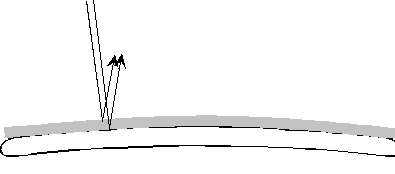
Another kind of interference that is rather easy to observe is interference though reflection. In the previous section we considered situations where there are two sources of waves, as there must be at least two waves to have interference. However, there are times when one wave can produce two waves and those two waves then interfere. The most common example of this is interference through reflection. Consider a pair of glasses that have what is called an "anti-reflection coating". This is a very thin transparent coating placed on top of an eyeglass lens:

Normally, a piece of glass, like an eyeglass lens reflects a fair amount of light, about 4%. Although this may seems small, it can be distracting when talking to someone wearing glasses, especially if there are bright lights around. The reflection is particularly noticeable in photographs or on television because of the bright flash or camera lights. These reflections would cause problems within a camera, as a camera lens is not a simple lens like in eyeglasses. Rather, a good camera lens is actually composed of up to ten individual lenses. If each lens reflected some light, there would be a lot of light bouncing around inside the camera, washing out the photograph. Thus, scientists came up with a way to suppress the reflections using the principle of interference.
Looking at the figure above, a single wave comes down and strikes the eyeglass lens. A small part of the wave reflects off of the first surface – the top of the coating. The rest of the wave is transmitted. However, a small part of the transmitted wave then reflects off of the lens, itself. Thus, two waves are now traveling up. These two waves can interfere and we want to know whether there will be constructive or destructive interference.
Using the method discussed in the previous section, there are always two parts to a question like this. The first part involves using the figure to determine the difference in path length between the observer and the two waves. To do this, let's enlarge the figure above:
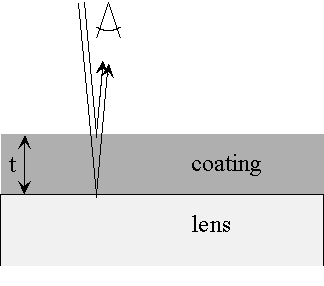
Again, we see that one of the waves reflects off of the coating and travels straight to the observer. The second wave travels through the coating before reflecting off of the lens itself. If the thickness of the coating is called "t", then the second wave travels a distance 2t compared to the first wave. Remember it has to travel through the coating in each direction. So, the difference in path length traveled by the two waves, R2 - R1, is just 2t.
The second step in the analysis is recalling the conditions for constructive and destructive interference. In the path length difference, R2 - R1, is a multiple of a wavelength, nl , then there will be constructive interference. If R2 - R1 = ½l + nl , then there will be destructive interference.
In this example, we want to suppress the reflection, so we want the two waves to cancel each other out, or, we want destructive interference. The simplest condition for destructive interference is R2 - R1 = ½l . We can now bring these two pieces of information together:
Path length difference from diagram:
R2 - R1 = 2t.
Path length difference for destructive interference:
R2 - R1 = ½l .
Now, we can equate these two expressions, and we find the 2t = ½l . Or, we can write that t = l /4. This is our final result: a simple lens will reflect about 4% of the light striking it. However, if you place a transparent coating over the lens, the reflected light will be reduced almost of zero through destructive interference. We will discuss the properties of light later in this chapter, but for now, we just need to know the wavelength of the light. In the range of light that we can see, the wavelength is roughly 0.5 m m. So, the thickness of the "antireflection coating" needs to be about a quarter of this, or about 0.125 m m. Of course, this is very thin, but sophisticated techniques have been developed to apply coatings of this thickness very precisely. It does add about $50-100 to the price of the lens, but it can be worth it. As stated above, in more complex optical systems, like camera lenses, zoom lenses, binoculars, telescopes, etc., antireflection coatings are absolutely essential. Here is a photograph of two pairs of glasses. The upper one has the antireflection coating, while the lower one does not:

One major problem with these coatings is that they must be kept very clean. If you leave a fingerprint on a lens, the thickness of the oil layer that is left behind can easily be in the range of m m's. Notice that if the coating thickness is t = l /2, we will have constructive interference, which will make the reflected light brighter. This is why the thickness must be controlled so carefully, and why dirt on the surface can so easily disrupt the conditions for destructive interference.
Of course, creative entrepreneurs will always find a way to take advantage of this delicate balance. Imagine that you apply a coating to a surface that is not flat, but has been patterned in some way:
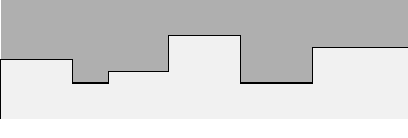
The spots where the thickness produces destructive interference will appear
dark, while the spots where there is constructive interference will appear bright.
This produces interesting patterns of light and dark. In fact, it is a bit more
complicated since the conditions for constructive and destructive interference
depend on the wavelength of the light. The wavelength of light determines the
color that you perceive. So, different colors will show different patterns of
constructive and destructive interference giving a striking "rainbow" effect.
This effect has been used to make shiny colorful wrapping paper:
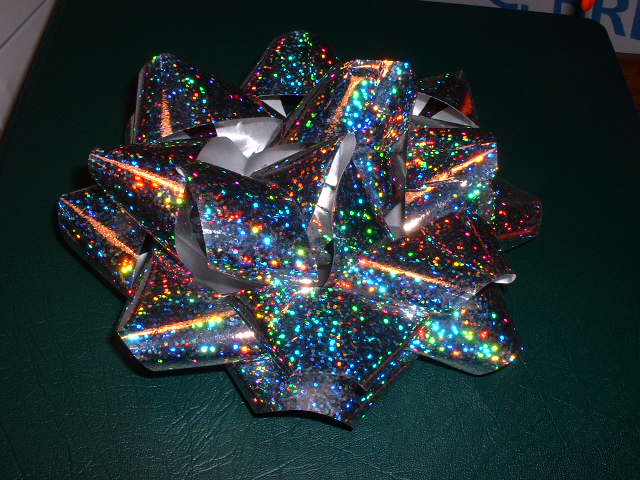
Another manifestation of this is the colors that you often see in puddles in the road. Just like glass, water reflects about 4% of the light striking it. Now, roads contain a lot of oil and some of this oil gets into the puddle. Since oil is lighter than water it rises to the surface and spreads out over the water, producing a thin film. This film of oil acts like the coating that we discussed about. However, the thickness is not precisely controlled, so it will not produce purely constructive or destructive interference. However, it does affect how much light of each color is reflected. This produces the patterns of very pure colors that you often see when looking at a puddle of water.
Sound waves in reflection
Interference in reflection has its most important applications when applied to light waves. However, there are some similar situations for sound waves. Imagine the cross-section of a standard wall. There is an exterior wall, an interior wall and a gap in between for insulation:
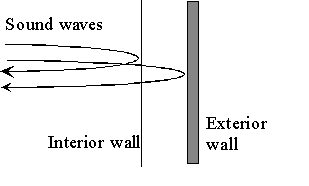
When a sound wave strikes this structure, it produces two reflected waves that can interference, just like light waves. Also, the conditions are just the same. Let the gap in the wall be called "t". If t = l /4 there will be destructive interference and if t = l /2, there will be constructive interference.
Another example of interference of sound comes from reflection from steps. A common situation involves hitting a bass drum in a football field in front of a set of bleachers:
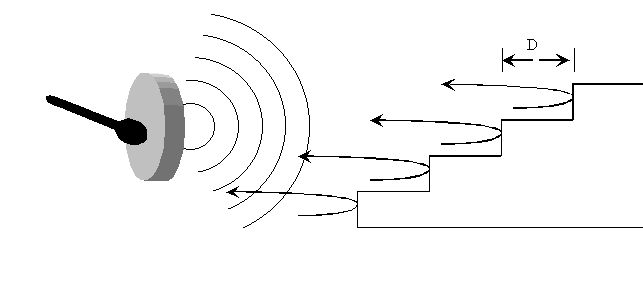
Again, if the depth of each step is given by "D", then the conditions for destructive interference are D = l /4. There will be constructive interference if D = l /2. The bass drum produces many frequencies. The frequencies that produce constructive interference will reflect strongly. So, even though the bass drum does not produce a distinct pitch, the reflected sound does have a clear pitch corresponding to the frequencies that interfere constructively.